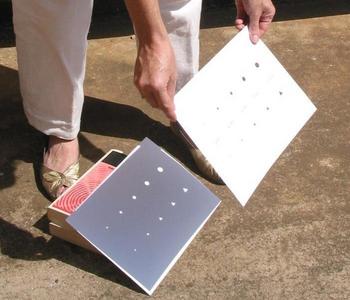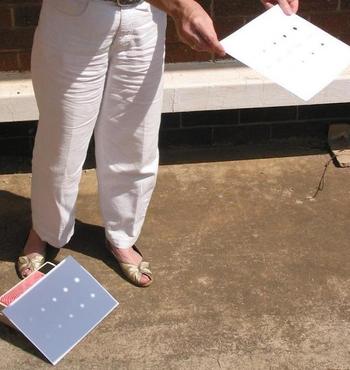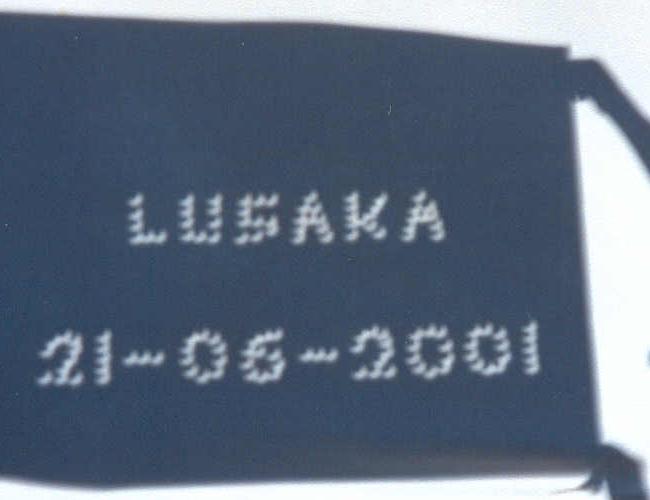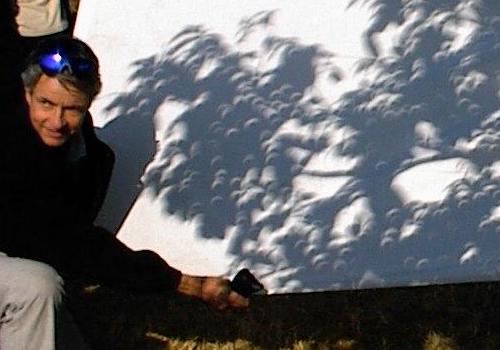Watch the eclipse safely with pinhole projection
A small hole cut in a piece of paper or card will clearly and safely let you
watch the eclipse. How? Let the Sun shine through the hole onto a piece of
white paper or card held some distance away. One might think that the
projected light of the Sun will have the shape of the hole, but this is only
true if the hole is close to the projection surface. The pictures below show
this.
Pinhole projection is an easy way for individuals to watch the
eclipse. Most people have some paper, card or cardboard available, so it
costs nothing.
Make sure that you stand with your back to the Sun. Do not let anyone
look through the pinhole - only use it to project an image of the Sun as
shown.
The simplest Pinhole Projector is your hand

Click on the picture for a larger
version
Make a small gap between your thumb and
forefinger and let the Sun shine through it on onto a flat, light-coloured
surface. The sunlight passing through the gap will show the shape of the
Sun - here the Sun is not eclipsed, and it looks circular.
Make your own Personal Pinhole Projector

Click on the picture for the full
image.
Here is a Personal Pinhole Projector in action.
If you look closely,
- What is the shape of the hole?
- What is the shape of the projected image of the Sun?
Maybe we need to see what shape and size pinhole is needed to make a good
image of the Sun.
Testing Pinhole Projection
We made a test card with round holes and with triangular holes of different
sizes, and held it a different distances from our projection screen.

Click on the picture for the full
image.
Card with round and triangular holes of 2, 4, 6, 8 and 10
mm diameter held 30 cm from a white card.
Projected sunlight has the
shape of the holes.

Click on the picture for the full
image.
Card with round and triangular holes of 2, 4, 6, 8 and 10
mm diameter held 1 metre from a white card.
Projected sunlight through
larger triangular holes is now halfway between the shape of the holes and
the round shape of the Sun. The smaller triangular holes are giving round
images.

Click on the picture for the full
image.
Card with round and triangular holes of 2, 4, 6, 8 and 10
mm diameter held 2 metres from a white card.
Projected sunlight thorugh
the large triangular holes now shows the round shape of the Sun, not the
shapes of the holes.
Only use the pinhole projector as shown. Do not look through the hole
at Sun, as you may damage your eyes.
Will a Pinhole show the shape of the partly eclipsed Sun?

The simplest and cheapest method of observing an eclipse of the Sun is by
pinhole projection. How does this work? The rays of light from the light
source must travel in straight lines through the pinhole. This results in a
reversed image of the light source being seen where the light of the image
falls.
This is easily shown with a clear incandescent light bulb, as found in
a normal household lamp. The filament in the these bulbs is held by several
loops of wire so as to form an arc made of several linear segments. This
looks rather like the shape of the partly eclipsed Sun.
To demonstrate pinhole projection we then need:
- a light bulb
- paper or card in which several small holes have been made
- a screen, such as a wall, on which the light passing through the
pinholes can fall.
We find that shape of the holes has no effect on the image of the filament
seen projected on the screen, if the paper is held far from the screen.
However, bigger holes will make brighter but more blurred images of the
filament.
Make a BIG pinhole projector
You could make a large pinhole projector that has your name or that of your
organisation, or where you plan to be for the eclipse:

Click on the picture for the
full image.
The place and time of the last total solar eclipse is
well recorded here.
Enjoy the eclipse from under a tree
Natural pinhole projection of the Sun occurs with the light passing between
the leaves of trees, in another picture taken in Lusaka during the last
solar eclipse:

Click on the picture for the
full image.
Africa in midsummer is hot! Relaxing under a tree may
be the answer.
www.hartrao.ac.za/other/eclipse2002/pinhole.html
Last updated 2002/11/13 by
mike@hartrao.ac.za
.
since 2002/10/14







